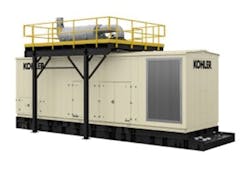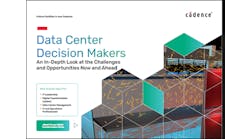Ryan Baumann is Global Director of Sales for Kohler Power Systems. As a power professional, Ryan has focused his efforts over the last 20 years with Kohler Power Systems to listening and growing from the various customers he’s engaged with. In his current role, Ryan is the Global Director for Kohler Power Systems where he is responsible for all Data Center projects and partners worldwide. During his tenure with Kohler, Ryan has enjoyed all aspects of the power business. His early days were spent commissioning mission critical facilities across the globe, designing cutting edge control systems, and managing all aspects of sales, design, training, and production for large custom power projects. Ryan is committed to continuous improvement, providing best in class product, processes, and strategies to give our customers an experience unparalleled in the market. Ryan is a graduate from the University of Wisconsin – Platteville, with a bachelor’s degree in electrical engineering. He and his wife, Jessica, enjoy travelling and exploring the country with their seven children.
Here’s the full text of Ryan Baumann’s insights from our Executive Roundtable:
Data Center Frontier: We’ve seen extraordinary demand for data center space thus far in 2022. What is driving the elevated demand for data center capacity?
Ryan Baumann, Kohler Power Systems: There are many factors pointing at the elevated demand for data center capacity. The onset of the COVID pandemic dramatically changed the way we work, in many ways for the better. Initially, out of necessity, we transformed the traditional workplace environment from common office spaces and in-person collaboration to home offices with online meetings. These new digital workloads have become commonplace, and are driving the need for continual growth within the data center sector.
Not only is the traditional office environment changing, but the industrial environment is evolving too. Equipment and facilities in sectors like manufacturing, refining, and agriculture are all finding new ways to boost efficiency through technologies that collect new data points and advance automation. This has spread the demand of data and transmission to new locations and markets.
Additionally, we are seeing data usage and creation in younger and younger consumers. Both the youngest and oldest in our homes are connected and generating data at astounding rates. This is absolutely the new normal, and certainly not an uptick. This technological renaissance will continue to drive growth in the data center sector as we continue to digitize and decentralize the workplace. It is exciting to be a part of, and to imagine where the data will take us in the future is truly exciting.
Data Center Frontier: Water scarcity has become a major concern in some data center markets. What are the best strategies to help reduce the impact of IT infrastructure on local water supplies?
Ryan Baumann: The most important consideration in real estate is location. Data center real estate and site selection requires striking a balance between proximity to data consumption, existing IT infrastructure, and reliable / affordable utilities. The modular and scalable aspects of electrical utilities allow data center operators considerable flexibility through substation planning, renewable build outs, and onsite generation.
However, water is a finite resource that is challenging to scale past what is already naturally available. Data centers must balance their design with what is realistic and sustainable for the geography of markets they wish to serve. Put differently, some communities need water more than they need fast data.
So, to best reduce water consumption data centers will have to redesign and reimagine cooling – CPUs that can operate at higher temperatures and for longer, dynamically migrate high demand workloads to areas where free-cooling is possible, and optimize thermal exchange through new technologies like immersion cooling. As companies work feverishly to reduce their carbon footprint, it will be necessary to drive just as passionately to reduce their water consumption.
Data Center Frontier: What’s the outlook for data center growth in regional “second tier” markets?
Ryan Baumann: As we’ve noted, data is being generated at a staggering pace and the users and creators are moving to markets further from the typical infrastructure of the internet backbone. As workloads shift to be closer to the growing “edge,” these “second tier” markets will need to grow to accommodate the additional decentralized compute.
Moreover, “first tier” markets will need the ability to push work loads to multiple secondary”markets. Depending on the market and how forward-looking the cities are can also be a significant barrier to the growth. It is important that these regional municipalities are creating the right incentives, and that data center clients are partnering with them and the local utilities, early and often. If not properly coordinated, a land parcel may be selected and secured, but electrical power may not either be available at the needed amount or take years to deliver to site. So careful planning is key.
Additionally, it is imperative that we all become brand ambassadors of our industry to help encourage an understanding of what a data center is, why we need to embrace it and how we can sell the need for them in new markets. The labor shortage is impacting all aspects of first- and second-tier markets. We need to engage and expose the next generation of diverse and passionate leaders in all aspects of this business to be our future leaders.
Data Center Frontier: A number of regions are facing limits on utility power availability for large users. What are the best options for data centers to operate and grow in power-constrained markets?
Ryan Baumann: Our goal to create a resilient power delivery system that focuses on the future, and considers new energy sources that must be coupled with the power of today. Combining traditional sources, such as nuclear and hydro, along with sustainable regional systems of solar, wind, fuel cells and battery storage will be needed to deliver robust power with a refreshed and bolstered power grid.
Bringing together our current power system, the macro-grid, and joining with site microgrids (wind/solar/fuel cells/back up sources) designed to support one another can help support the power constrained regions as well. Bearing in mind, nearly every data center is designed with an emergency backup power system, typically Tier 2 diesel generators sets, ready to serve power at a moment’s notice.
These generator sets built today are cleaner and significantly more efficient than their earlier cousins. Leveraging cleaner fuels, such as Hydrotreated Vegetable Oil (HVO) or natural gas generators in lieu of diesel, we can begin walking clear of fossil fuels. Emissions reduction strategies for the diesel backup power generators could allow the data center clients to run more frequently, if needed, during the grid constrained events to reduce the strain the data center is putting on the power network. Interruptible rate programs were a very common practice and may be needed again, while we continue to make our power consumption within data centers ever more efficient and strengthen the grid power.






